
 |
| Home |
Research |
|
|
The amazing story of radiative electron capture in forbidden transitions |
| This is a story of a project in experimental low-energy nuclear physics.
It goes back to 1983 when I started my Ph.D. work in the Nuclear
Spectroscopy Group at the Faculty of Physics of the University of
Warsaw under supervision of prof. Jan Żylicz. I obtained my
doctoral title in 1989 but the project continued and actually
culminated in 2015 by discovery of virtual beta-gamma transitions. Here is a brief summary of this amazing story. |
| 1. Introduction Electron Capture (EC) is a type of
nuclear beta decay. An atomic nucleus captures one of its orbital
electrons, whereby one proton changes into a neutron and an electron
neutrino is emitted. A hole in the atomic shell is filled in a
subsequent process by another electron which is accompanied by emission
of a characteristic X-ray. This radiation tells us from which orbit the
electron was captured. Normally, most probable is the capture from the
K-shell (1s capture) which is heralded by KX radiation.
In this story we consider only K-captures.
| |
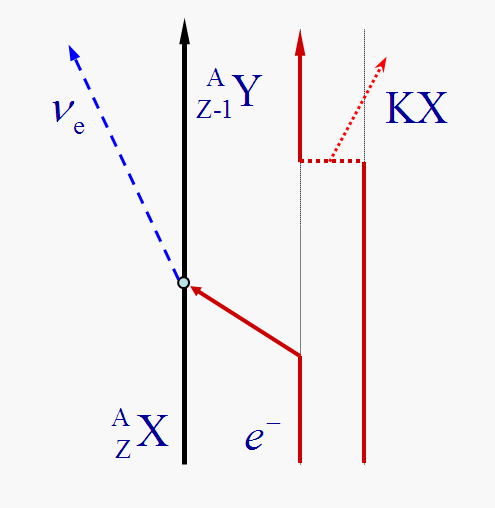 |
| Radiative Electron Capture (REC) is a second order process when in the primary transition a gamma photon is emitted in addition to a neutrino. This gamma radiation could be emitted by the captured electron (accelerated in the nuclear field) - such mechanism is called Internal Bremstrahlung (IB). Since the released energy is shared between three bodies (daughter nucleus, neutrino, photon) the energy spectrum of these photons is continuous. In addition to the shape of this spectrum, one can measure its intensity, usually given as the probability ratio of radiative-to-normal (non-radiative) capture. This ratio, integrated over all energy range, is of the order of 1E-4. | |
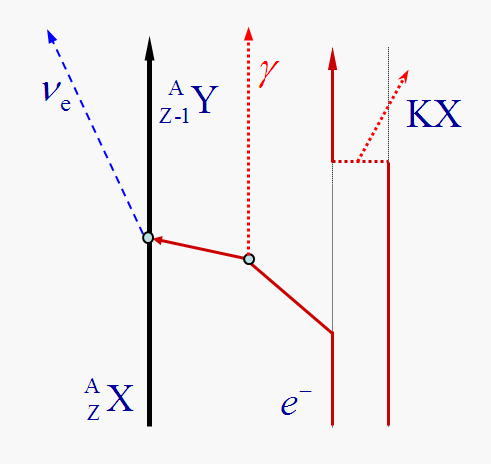 |
|
The REC spectra were measured for many cases of so called allowed beta
transitions (nuclear spin changes by 0 or 1 units, parity does not
change) and they were found in good agreement with theory assuming the
IB mechanism. These experiments and the IB theory are summarized in:
Bambynek et al., Rev. Mod. Phys. 49 (1977) 1. |
|
The IB theory was extended to all nuclear transitions, including so called forbidden
ones, by two Russian physicists Zon and Rapoport (ZR) in 1968, but it
was not tested experimentally. Initially, our motivation was to provide
such a test. In the following we will discuss two classes of decays
where nuclear spin changes by two units:
|
| 2. First cases and the puzzle The first case we've measured was the decay 41Ca -> 41K which is in the 1u class (nuclear transition from 7/2- to 3/2+). The
upper panel on the right shows the REC spectrum normalized to
non-radiative capture rate. In three different experiments the
K-capture component was selected by measuring gamma spectrum in
coincidence with the potassium KX-rays. The red line shows the simplest
model (Morrison and Schiff) which serves as a reference. To see better
the shape details, the ratio of the REC spectrum to this reference is
determined. Such a shape factor
for 41Ca is shown in the lower panel. In the following, all REC spectra
will be presented in the form of the corresponding shape factor. In the
lower panel the shape factor for the ZR theory is also shown (solid
line).
As can be seen, the measured intensity and the shape strongly deviate from the theory. The REC intesity is found 6 times larger than the prediction of the ZR theory!
The results for 41Ca were published in: Hornshoj et al., Nucl. Phys. A472 (1987) 139. Important: in the 1u
case, the ratio of REC to normal capture does not depend on nuclear
details (nuclear matrix elements cancel out)! The well known theory of
weak interactions and the quantum electrodynamics should suffice to
describe the data!
| |
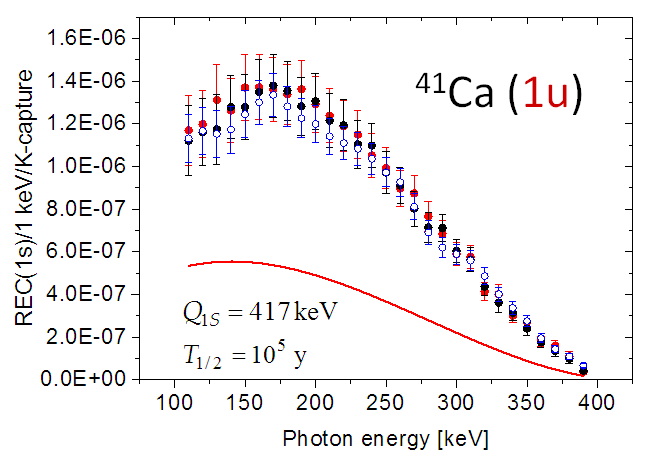 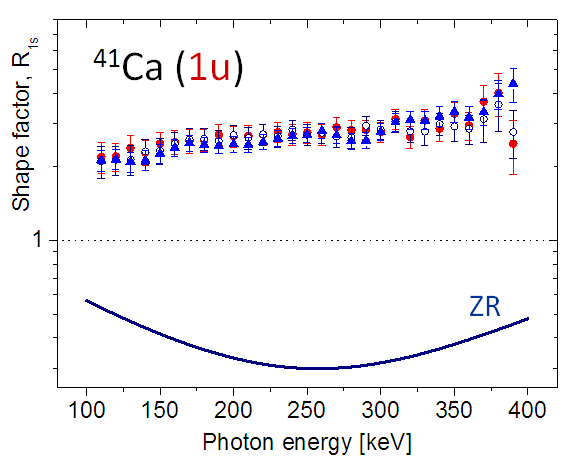 |
The second measured case was the 2nu
decay 59Ni -> 59Co. The corresponding shape factor, from two
different experiments, is shown on the right. Here, the difference with
respect to the 1u decays is that the REC spectrum depends on a combination of nuclear matrix elements, denoted by Lambda.
Since they are very difficult to calculate from nuclear theory, we
treat Lambda as an adjustable parameter. We found, however, that no
value of Lambda can fit the shape and the intensity of 59Ni spectrum
simultaneously! The prediction of ZR theory for the value of
Lambda=3.5, which fits best the shape of the experimental spectrum, is
shown by the solid line. Then, the measured intensity is 2 times larger than predicted! The results for 59Ni were published in:
Janas et al., Nucl. Phys. A524 (1991) 391. Thus, we have a puzzle: the model of ZR seems to be seriously wrong! |
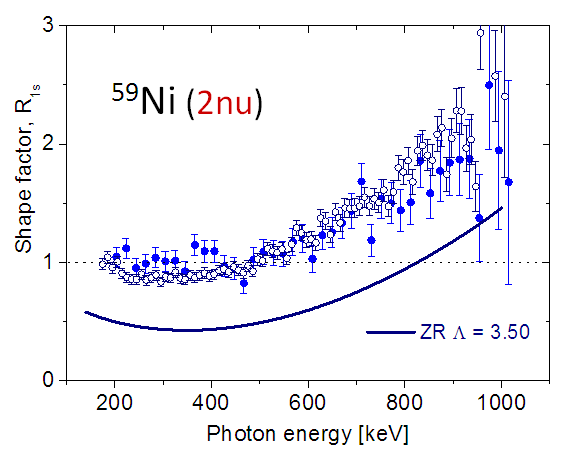 |
| 3. Do detour transitions solve the puzzle?
In fact, there is another way photons can be
emitted in the EC decay. The radiation can come from the nucleus! This
mechanism, represented by diagrams shown on the right, was considered
to be negligible in comparison with IB. It was noted, however, that in
case of forbidden EC the situation can be different. The direct 1u transition, for example, can be realized by a combination of allowed GT decay (much more probable than 1u) and E1 nuclear gamma transition!
| |
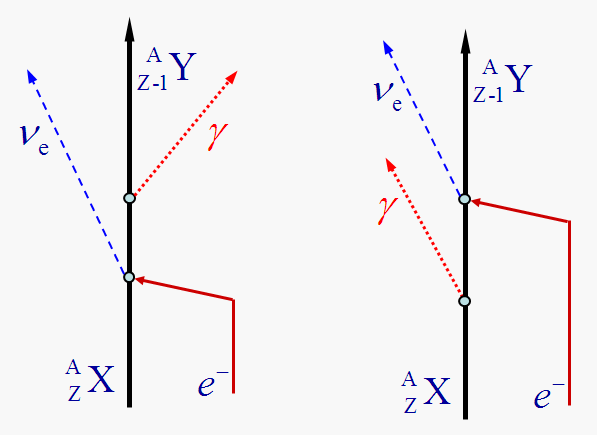 |
|
Ł. Kalinowski working in the framework of ZR
theory, calculated contributions of the detour diagrams to the REC
spectra of 41Ca and 59Ni. Here, an additional parameter, effective
charge, had to be introduced. On the plots below the predictions of the
new model (DT: ZR theory plus detour transitions) are shown by the
solid magenta line.The agreement is good when the value of the
effective charge is 0.78 in both cases! Although the physical meaning
of this effective charge was not entirely clear, it looked like the puzzle was solved.
The model of Kalinowski is descibed in: Kalinowski et al., Nucl. Phys. A537 (1992) 1 and Kalinowski, Nucl. Phys. A551 (1993) 473 |
| |
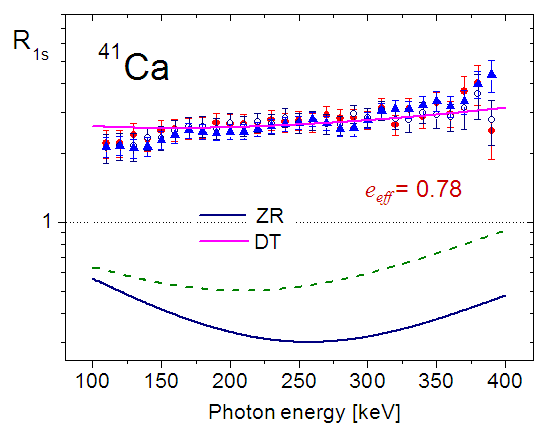 | 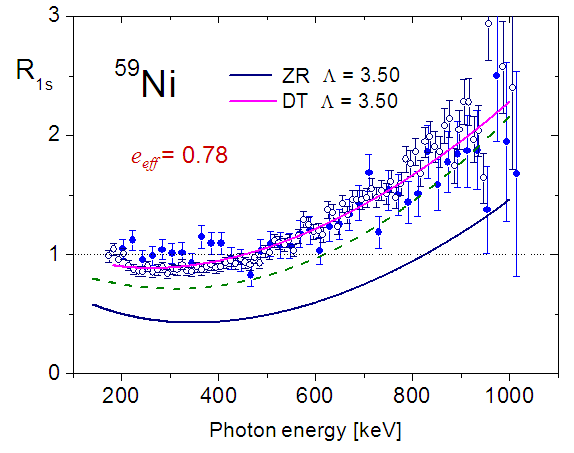 |
|
| 4. The puzzle remains
The problem reappeared when we measured REC in 204Tl which is of 1u type, see on the right. Here, in contrast to previous cases, the ZR theory predicts 4 times more radiation than is observed! Adding detour transitions makes it even worse, because for both signs of the effective charge the detour contribution is positive. The 204Tl case is described in: Kurcewicz et al., Nucl. Phys. A728 (2003) 3 | |
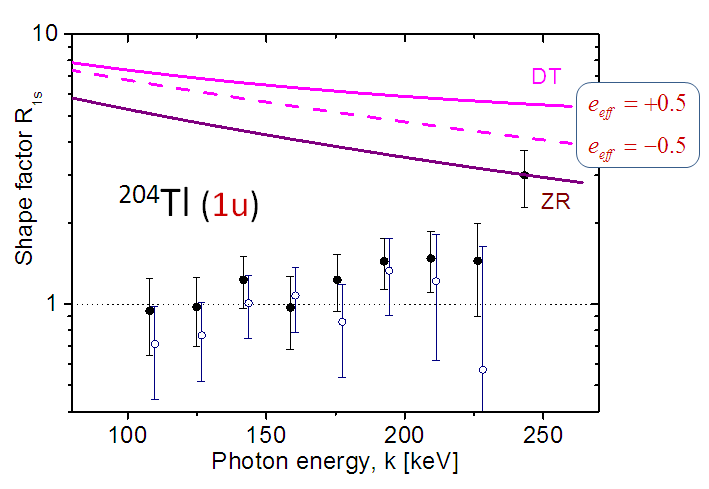 |
|
5. The breaktrough
The puzzle was finally solved by Krzysztof Pachucki (Faculty of Physics, University of Warsaw). He found an error in the ZR theory. Zon and Rapoport made a wrong approximation leading to some diverging terms. Pachucki noticed that when the electromagnetic field is described in the length gauge instead of previoiusly used Coulomb gauge, the diverging terms vanish! In addition, he showed that in the length gauge the contribution from the detour diagrams is negligible "unless there are close-lying states in the daughter or in the parent nucleus". The new theory (KP) was applied to the 1u REC and the very good agreement with the data was found (see below)! Afterwards, we measured another case of 1u transition, 81Kr, which fully confirmed the REC theory of Pachucki (below, on the right). Note that in the new theory there are no free parameters! As expected, the standard theory of weak interactions and QED do explain the REC in 1u transitions! The new theory is published in: Pachucki et al., Phys. Rev. C75 (2007) 055502, while the experiment on 81Kr in: Mianowski et al., Phys. Rev. C82 (2010) 044308 |
| |
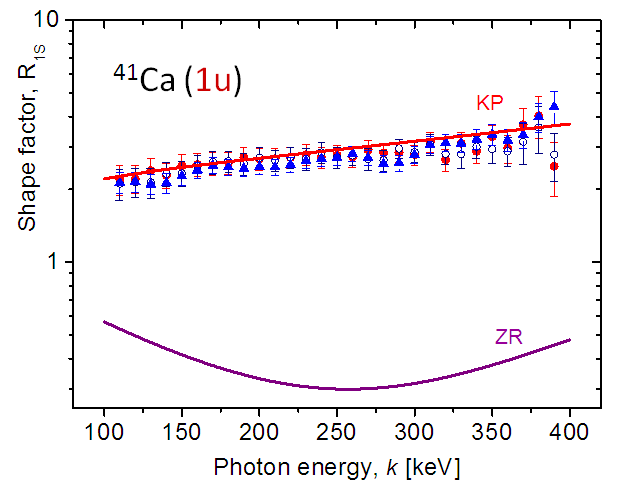 |
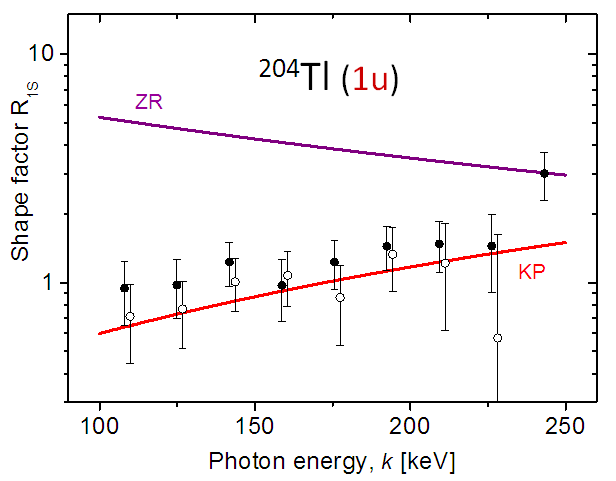 | 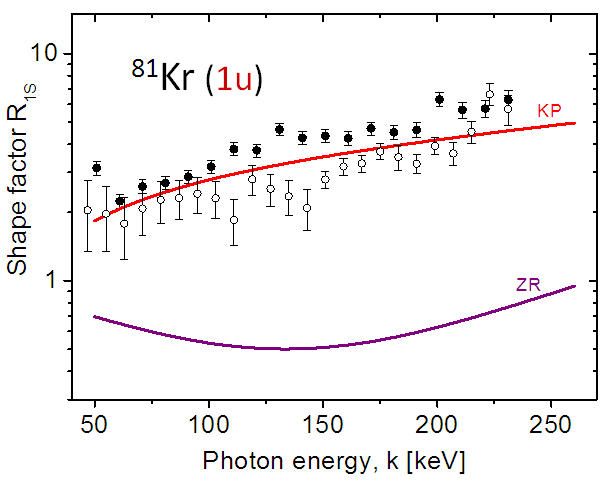 |
|
| 6. The bonus - evidence for virtual beta-gamma transition It remains to be seen how the new theory works in the 2nu case of 59Ni. It happens that the REC spectrum depends on the same nuclear matrix combination Lambda, as did the ZR theory. By setting its value to 1.5 the predicted spectrum almost agrees with the measured one (see on the right). In addition, there are good arguments that the value of Lambda equal to 1.5 is much more reasonable than 3.5, considered previously. We see, however, an excess of radiation in the high-energy end. | |
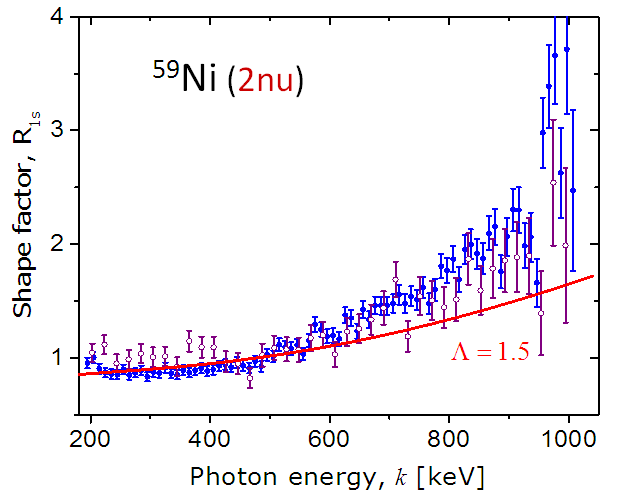 |
|
This excess, we believe, is a manifestation of a process which was
predicted in 1960s and sought for ever since. The radiative decay of
59Ni can proceed via an excited state in 59Co, located about 30 keV
above the initial state (see below on the left). This is an example of a virtual (detour) beta-gamma transition via a well defined nuclear state. The
influence of such a close-lying state
has to be explicitely added to the REC spectrum in the Pachucki's
theory. The contribution of this particular virtual transition was
calculated and the result is shown below on the right by the solid
green line. Finally, the gamma radiation emitted in the EC decay of
59Ni is a coherent sum of both electronic (IB) and nuclear (detour)
components. The latter is responsibe for about 4% of the total
intensity.
|
| |
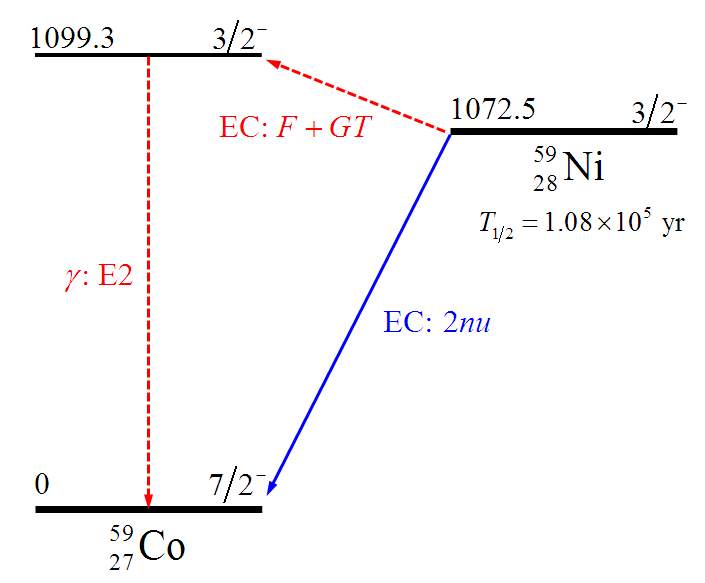 | 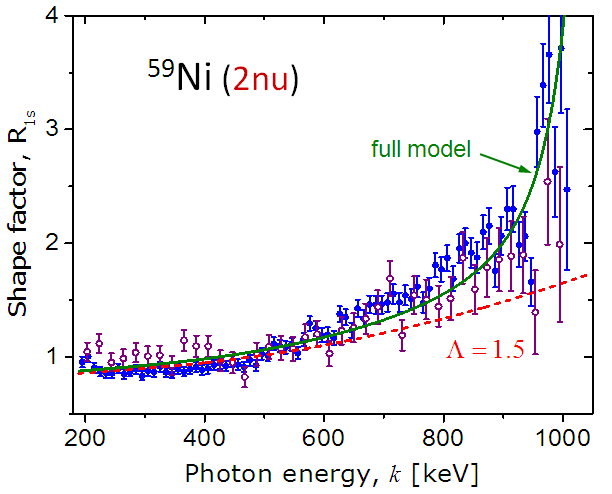 |
|
|
Now it became clear that previous efforts to
observe the virtual transition in 59Ni failed because the IB part was
described by the wrong ZR theory. The evidence for the detour
beta-gamma decay path poped-up once the contribution from the Internal
Bremsstrahlung was correctly calculated. The radiative decay of 59Ni
nicely illustrates the quantum mechanical principle that the evolution
of a physical system proceeds simultaneously through all possible
paths, including those that may temporarily violate the law of energy
conservation.
The detailed analysis of the 59Ni case is described in : Pfützner, Pachucki, Żylicz, Phys. Rev. C92 (2015) 044305. |
| Home |
Badania |